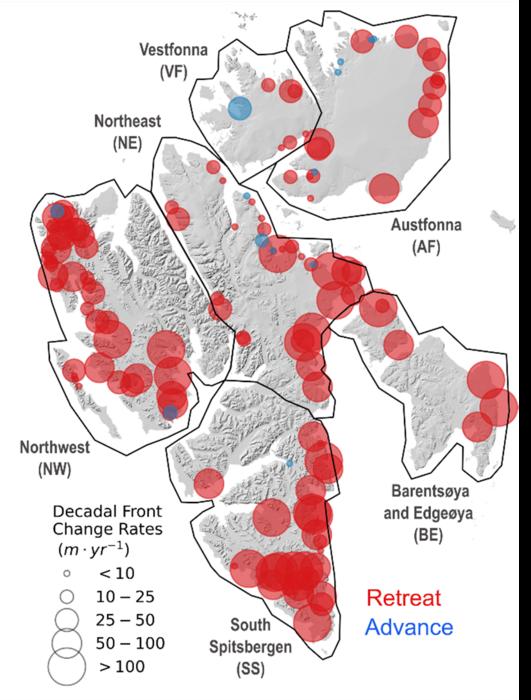
A new groundbreaking study led by researchers at the University of Bristol has shed light on the dramatic retreat of glaciers in Svalbard, one of the fastest-warming regions on the planet. The research, which was recently published in the esteemed journal Nature Communications, reveals startling findings that highlight the stark impact of climate change on these crucial ice formations. Over the past four decades, the data indicates that 91% of the glaciers across the archipelago have seen significant reductions in mass and extent—a worrying trend that questions the stability not only of these glaciers but also of global sea levels.
The study meticulously documented an astonishing area loss exceeding 800 square kilometers at the glacier margins since 1985, thereby illustrating a significant paradigm shift in our understanding of glacial dynamics under the influence of escalating temperatures. The research highlights a concerning trend where the most considerable glacier retreats have occurred in recent years, suggesting that the effects of climate change are accelerating more rapidly than previously anticipated. This data serves as a clarion call for urgent action against climate change, as the repercussions extend beyond just local ecosystems to global atmospheric and oceanic systems.
One of the fascinating aspects of the study is its examination of glacier calving cycles—an area where significant knowledge gaps have prevailed. The researchers discovered that over half (62%) of the glaciers analyzed undergo seasonal cycles of calving. This phenomenon occurs when warmer ocean and air temperatures create conditions where large chunks of ice break off from the glacier front, leading to further destabilization of already vulnerable ice masses. By employing advanced Artificial Intelligence methodologies, the research team was able to sift through millions of satellite images, revealing intricate details about these calving events and the overall end positions of the glaciers.
Dr. Tian Li, the lead author of the paper and a Senior Research Associate at the University of Bristol’s Glaciology Centre, stated that the extent of glacier retreats documented in this research is nothing short of astonishing. Such rapid loss across nearly the entire Svalbard region exemplifies the urgent need for more robust climate action, especially in areas that are warming at an alarming rate—up to seven times faster than the global average, in this case. This information is crucial for policymakers and stakeholders who need to understand the gravity of the situation when planning climate adaptation and resilience strategies.
Moreover, 2016 marked a turning point, as the research identified this year as the time when the rate of glacier retreats spiked dramatically. The calving rates were found to be double the average of the preceding years, indicating that specific climatic events, dubbed “atmospheric blocking,” could be driving these rapid changes. Atmospheric blocking is characterized by high-pressure systems that become stationary, subsequently leading to prolonged periods of extreme weather. This in turn has profound implications not only for the glaciers but also for regional climate patterns, potentially altering precipitation cycles and temperature fluctuations in the Arctic.
The implications of this research extend far beyond academic interest; they carry significant ramifications for global oceans and marine ecosystems. The study underscores that ongoing glacier retreats will impact ocean circulation patterns, which play a critical role in regulating climate not just locally but across the globe. As glaciers melt, the influx of freshwater into the oceans can disrupt salinity and current patterns, leading to changes in marine biodiversity and potentially jeopardizing fish stocks upon which many communities depend.
Understanding glacier dynamics, particularly the process of calving, is pivotal to devising models that can accurately predict future trends in these ice masses. Jonathan Bamber, a co-author of the study and a Professor of Glaciology, emphasized that this research sheds new light on what drives calving processes and emphasizes how these functions are intricately linked to climate change. The findings of this study are valuable not only for climate scientists but also for those involved in environmental policy-making, as they provide a clearer picture of what to expect in the future under various climate scenarios.
As Svalbard continues to experience unprecedented changes, the urgency for a deeper understanding of these phenomena becomes paramount. With a low altitude and a sensitive geographical position in the high North Atlantic, the archipelago embodies the frontline of climate change, making it a focal point for future research initiatives aimed at unraveling the complexities of glacial behavior in warming conditions. These researchers have set a precedent for future studies, emphasizing the need for combining traditional research methodologies with advanced technologies like AI in order to deepen our understanding of the rapidly changing environments.
The comprehensive nature of the study, combined with its reliance on cutting-edge technology and methodologies, offers a transformative approach to glaciology. As scientists continue to enhance their capabilities in analyzing and interpreting large sets of data, new insights will hopefully emerge that can inform global responses to climate change. This research stands as a testament to the proactive steps needed in academia, where innovative methodologies can significantly advance the understanding of pressing environmental issues.
In conclusion, the study from the University of Bristol serves as a powerful reminder of the critical state of the world’s glaciers, particularly in sensitive regions like Svalbard. The alarming trends observed in glacier retreat call for heightened global attention and immediate action. The complexities surrounding climate change and glacier dynamics remain vast and warrant continuous exploration, making studies of this caliber invaluable for both scientific advancement and impactful environmental policy.
Subject of Research: Glacial Retreat in Svalbard
Article Title: Pervasive glacier retreats across Svalbard from 1985 to 2023
News Publication Date: 16-Jan-2025
Web References: http://dx.doi.org/10.1038/s41467-025-55948-1
References: Nature Communications
Image Credits: Credit: University of Bristol
Keywords
Glaciers, Climate Change, Svalbard, Artificial Intelligence, Glaciology, Calving, Glacier Dynamics, Atmospheric Blocking, Environmental Policy, Ocean Circulation.





